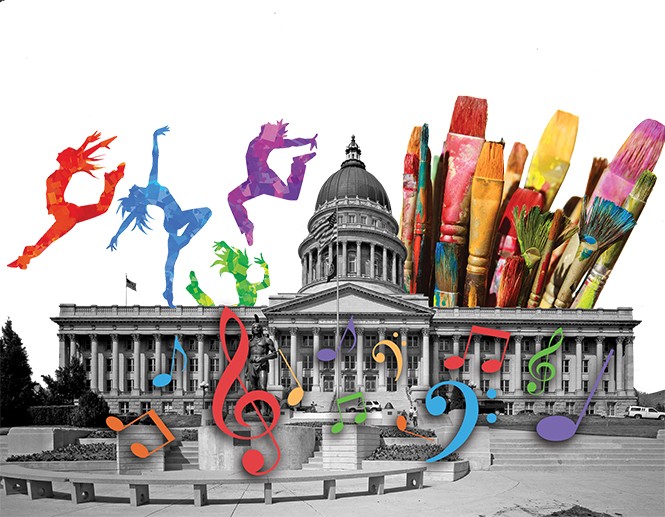State and the Arts
Utah might be a red state, but the picture for supporting the arts is far from blue.
By Scott Renshaw @scottrenshawWhen you think of a dyed-in-the-wool red state like Utah—where Republicans dominate at most every level of government—you might expect strict conservative principles applied to funding the arts and arts education. But the interaction between the state's art patrons, artists and public funding is more complicated.
As public information and data specialist for the Utah Division of Arts and Museums, David Wicai has mined a mountain of data to determine where Utah fits in the national picture of state arts organizations in terms of funding. Every state agency provides an annual report to the National Assembly of State Arts Agencies including information about per-capita public funding, yet it's not always easy to define what programs should be considered in those figures, since each state arts agency might have a different mandate and incorporate different kinds of programs.
"There are state-funded programs [in Utah] that are part of the state Office of Education," Wicai says. "It doesn't come through the arts budget, but still deals with arts. ... Some [states] have no extra programs, some had money going to corrections, some coming out of departments of commerce."
Based on the best available information, and incorporating Utah's funding for arts education in addition to the UDAM's $4.2 million FY2016 budget, Wicai estimates that Utah's per-capita annual public arts spending is $4.71. That would rank Utah second—behind only New Mexico—among the states in the Western States Arts Federation, which also includes Alaska, Arizona, California, Colorado, Hawaii, Idaho, Montana, Nevada, Oregon, Washington and Wyoming.
And that figure only addresses spending at the state level. Utah arts organizations also benefit from Salt Lake County's Zoo, Arts & Parks (ZAP) tax, Summit County's Recreation and other similar local and municipal programs, making precise calculations even more challenging.
Such a level of support, however, seems to be in keeping with Utah's history of creating the first state-funded arts agency in the country in 1899—some 20 years ahead of the next state arts agency, and more than 50 years ahead of the creation of the federal-level National Endowment for the Arts. It's also in line with more current statistics, including data from the NEA's 2016 Survey of Public Participation in the Arts, which noted that 84.5 percent of Utah adults attended a visual or performing arts event in 2015—the highest rate in the nation.
"That's kind of the ongoing challenge and question we have internally," Wicai says, "which is, what do we do with these very strong numbers? We need to continue being a leader with arts support and participation to continue that trend."
That doesn't mean that local arts organizations shouldn't seek even more public support, even as they appreciate what they already have. Jerry Rapier, artistic director of Plan-B Theatre Co., observes that ZAP in particular has "not only stabilized many Salt Lake County organizations, it has allowed them to take risks and thrive. ... Most public entities allow application for general operating funds, the importance and value of which cannot be overstated."
But while county and municipal support continues to grow, Rapier says, "things are a little less clear on the state level. I personally feel that the Legislature is not as in tune with the needs of artists and arts organizations as the city and county programs seem to be. ... The number of organizations applying for funding steadily increases each year, while the funding itself remains flat."
Arts education also remains a key component in the overall picture of support for the arts, as the Utah Education Association and other advocates for the arts continue to push for increased funding for public-school arts programs, as well as the grants for educators offered through UDAM. "As a parent and an artist, I strongly feel that there can never be too much arts education in schools," Rapier says. "There should be work by educators in tandem with the regular presence of professional artists to expose students to the depth and breadth of the arts themselves and also how easily and effectively the arts can be integrated into any other profession. And given that K-12 education is publicly funded, there is no question in my mind that arts education should also be publicly funded."
But while there is always room for improvement, Utah's level of support offers optimism for those who value the importance of the arts for a community's vitality. "I think that there is incredible support for the arts in Utah, whether it's state-funded or privately funded," Wicai says. "I think we are a national leader. If you were thinking, who are the top states in terms of arts funding, Utah probably wouldn't come first. But we're working on everyone starting to understand that."
More by Scott Renshaw
-
Film Reviews: New Releases for April 19
The Ministry of Ungentlemanly Warfare, Abigail, The Beast, Hard Miles, Sasquatch Sunset and more
- Apr 19, 2024
-
Faces of Salt Lake County book and portrait reception
Images and personal stories in a new book reveal local demographic diversity
- Apr 17, 2024
-
Feature film review: THE BEAST
A filmmaker's compelling ideas get a bit tangled in references to his creative influences.
- Apr 17, 2024
- More »
Latest in Arts & Entertainment
Readers also liked…
-
New TV for January 2023
Mayfair Witches, Velma, The Last of Us, Poker Face and more premieres
- Jan 4, 2023




